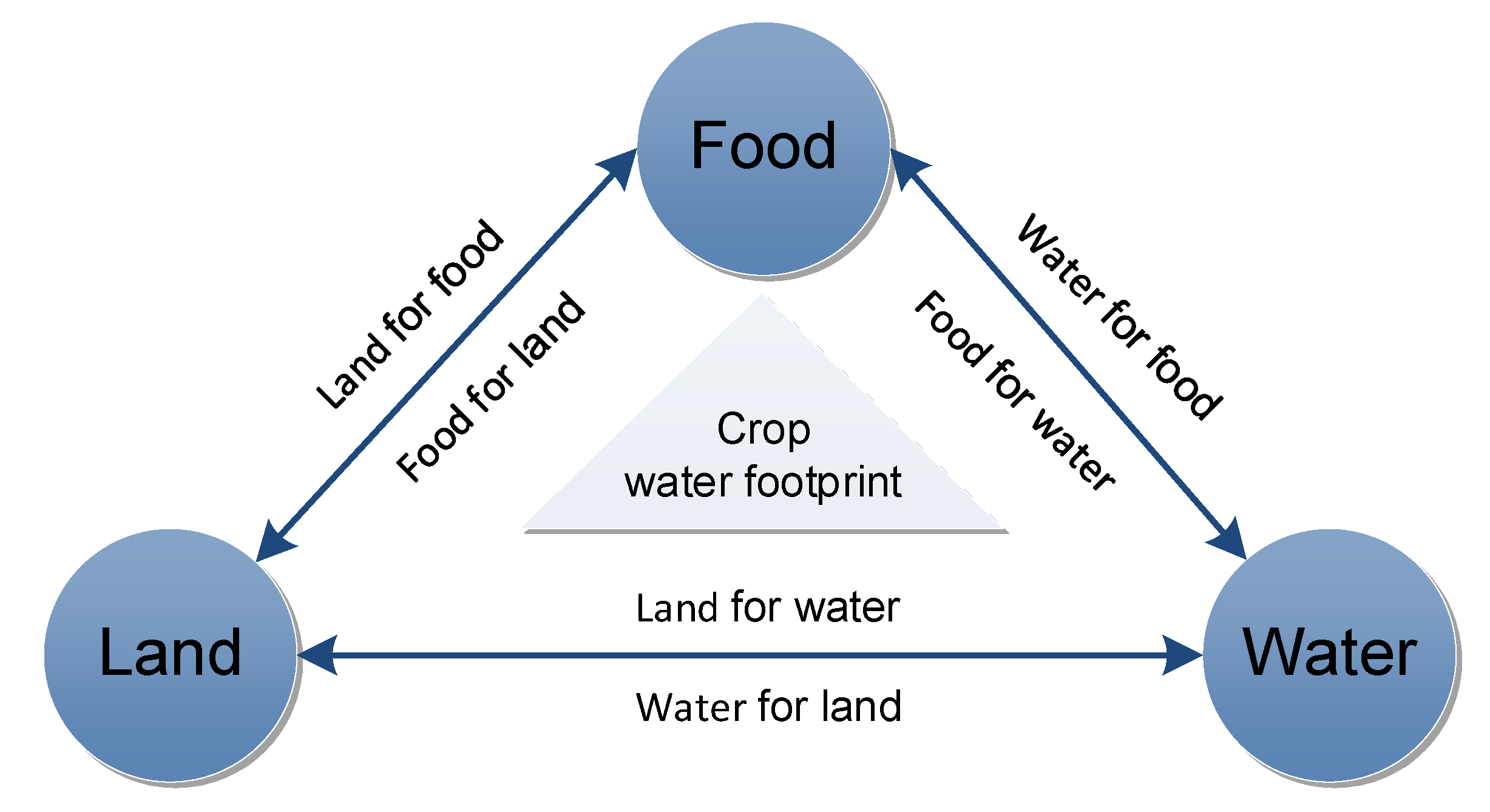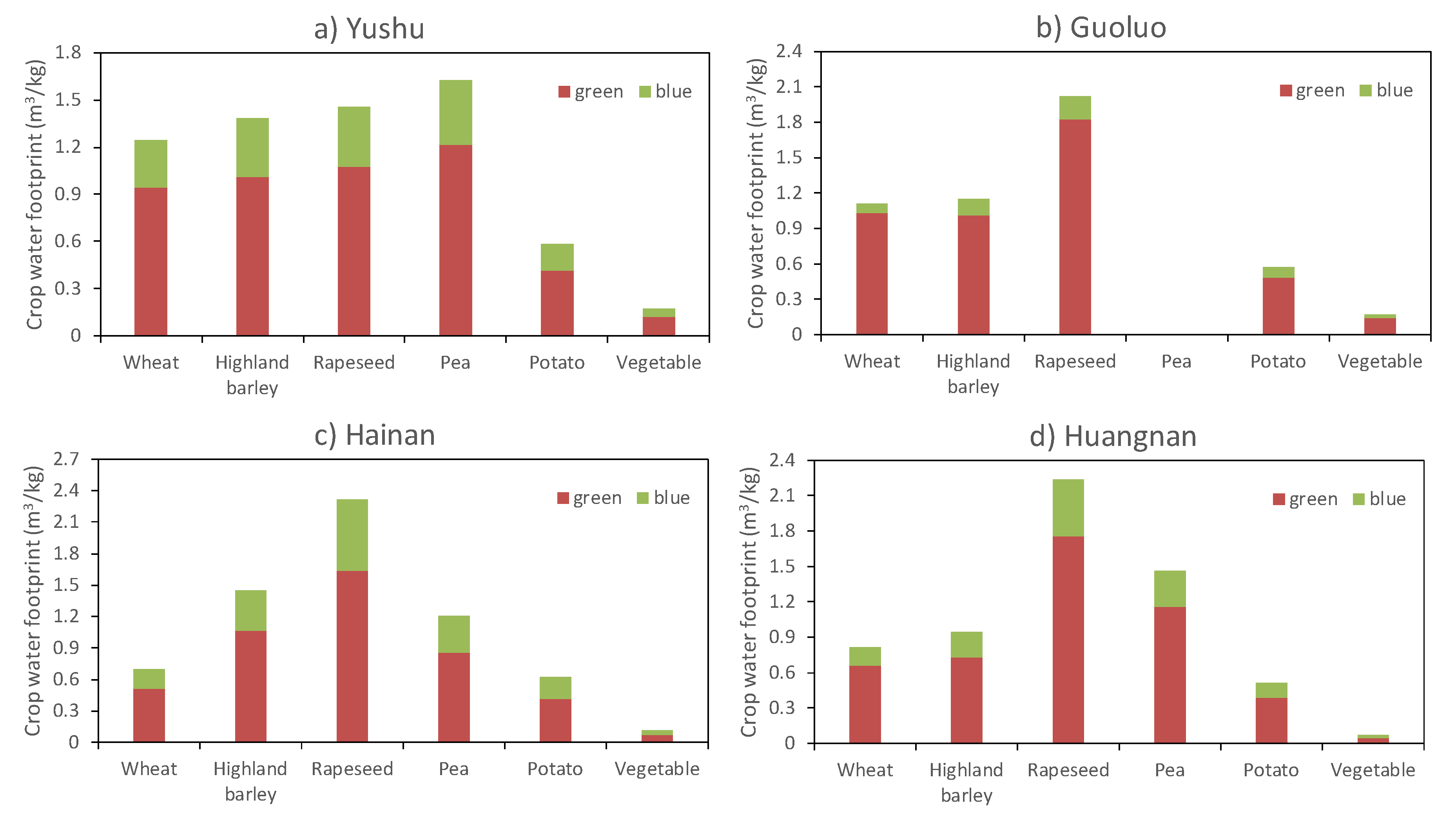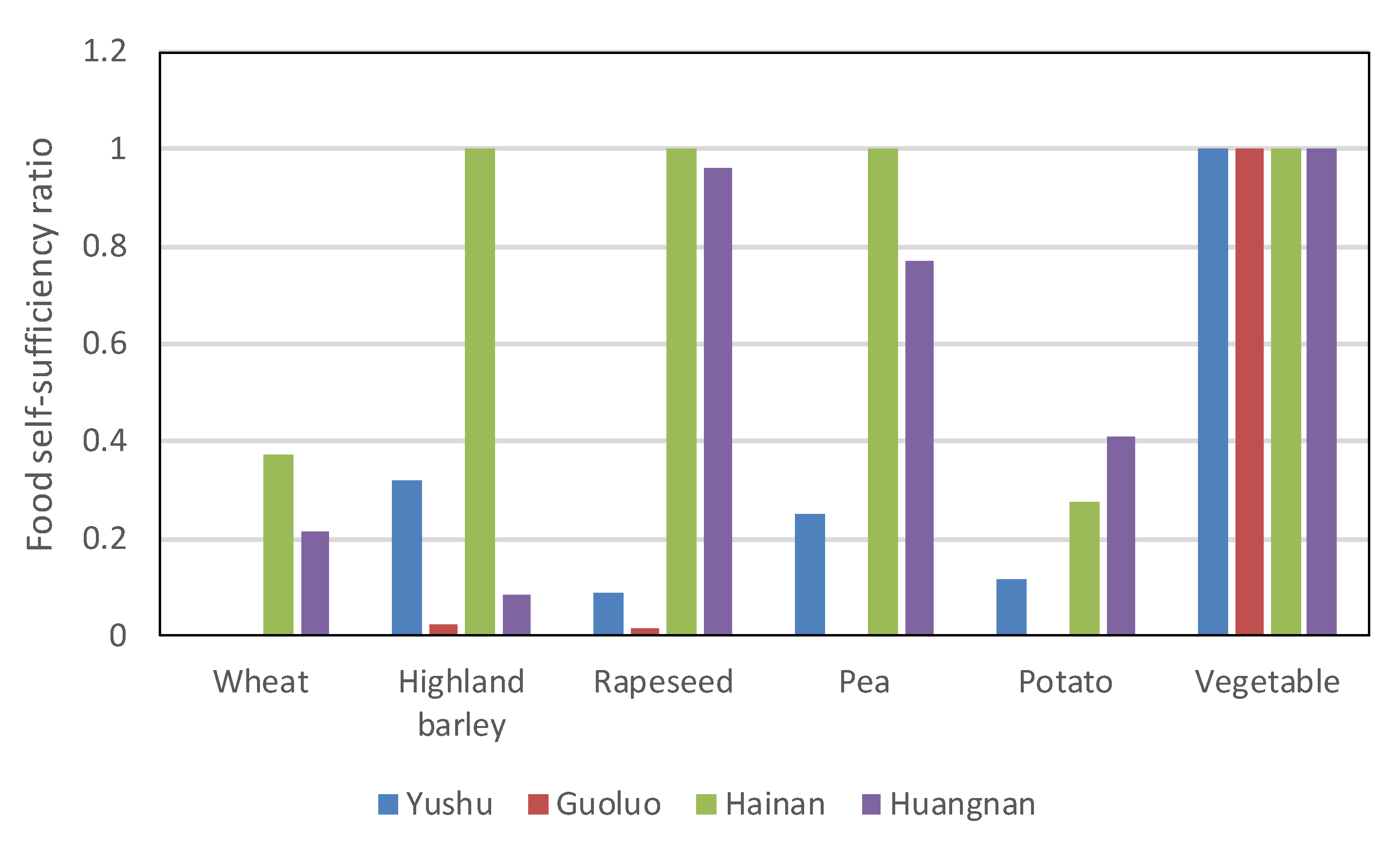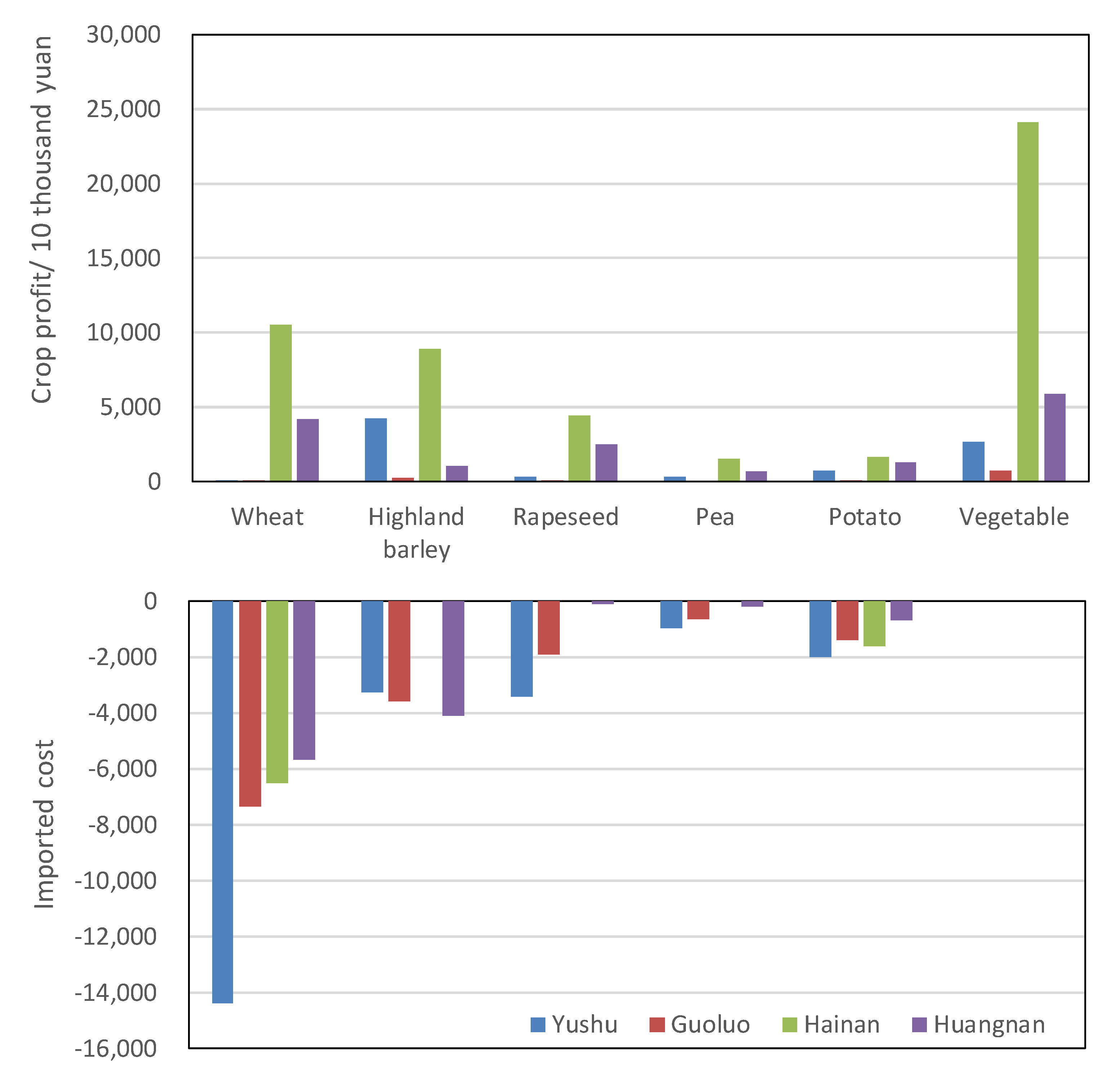Integrated Modeling Approach for Sustainable Land-Water-Food Nexus Management
Abstract
1. Introduction
2. Method and Model Formulation
2.1. Land-Water-Food Nexus Management
2.2. Objective Function and Decision Variables
2.3. Constraints
2.3.1. Food Demand Constraints
2.3.2. Food Security Constraints
2.3.3. Water Constraints
- (1)
- Crop water footprint accounting
- (2)
- Crop irrigation water constraints
2.3.4. Land Constraints
2.3.5. Non-Negativity Constraints
2.4. Solution Method
2.4.1. Transformation of the Ratio Objective
2.4.2. Transformation of the Imprecise Objective
3. Case Study
3.1. Overview of Study System
3.2. Data Source
4. Results and Discussions
4.1. Crop Water Footprints
4.2. Optimal Plans of Crop Cultivation Reconfiguration
4.3. Discussion
5. Conclusions
Supplementary Materials
Author Contributions
Funding
Conflicts of Interest
References
- Kang, S.; Hao, X.; Du, T.; Tong, L.; Su, X.; Lu, H.; Li, X.; Huo, Z.; Li, S.; Ding, R. Improving agricultural water productivity to ensure food security in China under changing environment: From research to practice. Agric. Water Manag. 2017, 179, 5–17. [Google Scholar] [CrossRef]
- FAO. Scarcity and Degradation of Land and Water: Growing Threat to Food Security. 2011. Available online: http://www.fao.org/news/story/en/item/95153/icode/ (accessed on 1 September 2019).
- Misselhorn, A.; Aggarwal, P.; Ericksen, P.; Gregory, P.; Horn-Phathanothai, L.; Ingram, J.; Wiebe, K. A vision for attaining food security. Curr. Opin. Environ. Sustain. 2012, 4, 7–17. [Google Scholar] [CrossRef]
- Niu, G.; Zheng, Y.; Han, F.; Qin, H. The nexus of water, ecosystems and agriculture in arid areas: A multiobjective optimization study on system efficiencies. Agric. Water Manag. 2019, 223, 10569. [Google Scholar] [CrossRef]
- Ren, D.; Yang, Y.; Yang, Y.; Richards, K.; Zhou, X. Land-Water-Food Nexus and indications of crop adjustment for water shortage solution. Sci. Total Environ. 2018, 626, 11–21. [Google Scholar] [CrossRef]
- Duan, W.; Chen, Y.; Zou, S.; Nover, D. Managing the water-climate- food nexus for sustainable development in Turkmenistan. J. Clean. Prod. 2019, 220, 212–224. [Google Scholar] [CrossRef]
- Darshana, A.; Ostrowski, M.; Pandey, R.P. Simulation and optimization for irrigation and crop planning. Irrig. Drain. 2012, 61, 178–188. [Google Scholar] [CrossRef]
- Li, M.; Guo, P. A multi-objective optimal allocation model for irrigation water resources under multiple uncertainties. Appl. Math. Model. 2014, 38, 4897–4911. [Google Scholar] [CrossRef]
- Bas, E. A robust optimization approach to diet problem with overall glycemic load as objective function. Appl. Math. Model. 2014, 38, 4926–4940. [Google Scholar] [CrossRef]
- Gephart, J.A.; Davis, K.F.; Emery, K.A.; Leach, A.M.; Galloway, J.N.; Pace, M.L. The environmental cost of subsistence: optimizing diets to minimize footprints. Sci. Total Environ. 2016, 553, 120–127. [Google Scholar] [CrossRef]
- Jiang, Y.; Xu, X.; Huang, Q.; Huo, Z.; Huang, G. Optimizing regional irrigation water use by integrating a two-level optimization model and an agrohydrological model. Agric. Water Manag. 2016, 178, 76–88. [Google Scholar] [CrossRef]
- Varade, S.; Patel, J.N. Determination of Optimum Cropping Pattern Using Advanced Optimization Algorithms. J. Hydrol. Eng. 2018, 23, 05018010. [Google Scholar] [CrossRef]
- Garza-Díaz, L.E.; DeVincentis, A.J.; Sandoval-Solis, S.; Azizipour, M.; Ortiz-Partida, J.P.; Mahlknecht, J.; Cahn, M.; Medellin-Azuara, J.; Zaccaria, D.; Kisekka, I. Land-Use Optimization for Sustainable Agricultural Water Management in Pajaro Valley, California. J. Water Resour. Plan. Manag. 2019, 145, 05019018. [Google Scholar] [CrossRef]
- Li, M.; Singh, V.P. Sustainability of water and energy use for food production based on optimal allocation of agricultural irrigation water. Int. J. Water Resour. Dev. 2019, 36, 528–546. [Google Scholar] [CrossRef]
- Niu, G.; Li, Y.P.; Huang, G.H.; Liu, J.; Fan, Y.R. Crop planning and water resource allocation for sustainable development of an irrigation region in China under multiple uncertainties. Agric. Water Manag. 2016, 166, 53–69. [Google Scholar] [CrossRef]
- Elleuch, M.A.; Anane, M.; Euchi, J.; Frikha, A. Hybrid fuzzy multi-criteria decision making to solve the irrigation water allocation problem in the Tunisian case. Agric. Syst. 2019, 176, 102644. [Google Scholar] [CrossRef]
- Cheviron, B.; Vervoort, R.W.; Albasha, R.; Dairon, R.; Le Priol, C.; Mailhol, J.C. A framework to use crop models for multi-objective constrained optimization of irrigation strategies. Environ. Model. Softw. 2016, 86, 145–157. [Google Scholar] [CrossRef]
- PCampana, P.E.; Zhang, J.; Yao, T.; Andersson, S.; Landelius, T.; Melton, F.; Yan, J. Managing agricultural drought in Sweden using a novel spatially-explicit model from the perspective of water-food-energy nexus. J. Clean. Prod. 2018, 197, 1382–1393. [Google Scholar] [CrossRef]
- Habteyes, B.G.W.; Frank, A. Economics of irrigation water conservation: Dynamic optimization for consumption and investment. J. Environ. Manag. 2000, 258, 110040. [Google Scholar] [CrossRef]
- Mortada, S.; Najm, M.A.; Yassine, A.; El Fadel, M.; Alamiddine, I. Towards sustainable water-food nexus: An optimization approach. J. Clean. Prod. 2018, 178, 408–418. [Google Scholar] [CrossRef]
- YNie, Y.; Avraamidou, S.; Xiao, X.; Pistikopoulos, E.N.; Li, J.; Zeng, Y.; Song, F.; Yu, J.; Zhu, M. A Food-Energy-Water Nexus approach for land use optimization. Sci. Total Environ. 2019, 659, 7–19. [Google Scholar]
- Liu, X.; Guo, P.; Li, F.; Zheng, W. Optimization of planning structure in irrigated district considering water footprint under uncertainty. J. Clean. Prod. 2019, 210, 1270–1280. [Google Scholar] [CrossRef]
- Li, M.; Fu, Q.; Singh, V.P.; Liu, D.; Li, T.; Zhou, Y. Managing agricultural water and land resources with tradeoff between economic, environmental, and social considerations: A multi-objective non-linear optimization model under uncertainty. Agric. Syst. 2020, 178, 102685. [Google Scholar] [CrossRef]
- Ren, C.; Guo, P.; Tan, Q.; Zhang, L. A multi-objective fuzzy programming model for optimal use of irrigation water and land resources under uncertainty in Gansu Province, China. J. Clean. Prod. 2017, 164, 85–94. [Google Scholar] [CrossRef]
- Li, M.; Fu, Q.; Singh, V.P.; Ji, Y.; Liu, D.; Zhang, C.; Li, T. An optimal modelling approach for managing agricultural water-energy-food nexus under uncertainty. Sci. Total Environ. 2019, 651, 1416–1434. [Google Scholar] [CrossRef]
- Tang, Y.; Zhang, F.; Wang, S.; Zhang, X.; Guo, S.; Guo, P. A distributed interval nonlinear multiobjective programming approach for optimal irrigation water management in an arid area. Agric. Water Manag. 2019, 220, 13–26. [Google Scholar] [CrossRef]
- Linker, R.; Ioslovich, I.; Sylaios, G.; Plauborg, F.; Battilani, A. Optimal model-based deficit irrigation scheduling using AquaCrop: A simulation study with cotton, potato and tomato. Agric. Water Manag. 2016, 163, 236–243. [Google Scholar] [CrossRef]
- Dunnett, A.; Shirsath, P.B.; Aggarwal, P.K.; Thornton, P.; Joshi, P.K.; Pal, B.D.; Khatri-Chhetri, A.; Ghosh, J. Multi-objective land use allocation modelling for prioritizing climate-smart agricultural interventions. Ecol. Model. 2018, 381, 23–35. [Google Scholar] [CrossRef]
- Davijani, M.H.; Banihabib, M.E.; Anvar, A.N.; Hashemi, S.R. Multi-objective optimization model for the allocation of water resources in arid regions based on the maximization of socioeconomic efficiency. Water Resour. Manag. 2016, 30, 927–946. [Google Scholar] [CrossRef]
- Tan, Q.; Zhang, S.; Li, R. Optimal Use of AgriculturalWater and Land Resources through Reconfiguring Crop Planting Structure under Socioeconomic and Ecological Objectives. Water 2017, 9, 488. [Google Scholar] [CrossRef]
- Galan-Martin, A.; Vaskan, P.; Anton, A.; Esteller, L.J.; Guillén-Gosálbez, G. Multi-objective optimization of rainfed and irrigated agricultural areas considering production and environmental criteria: a case study of wheat production in Spain. J. Clean. Prod. 2017, 140, 816–830. [Google Scholar] [CrossRef]
- Li, M.; Fu, Q.; Singh, V.P.; Liu, D. An interval multi-objective programming model for irrigation water allocation under uncertainty. Agric. Water Manag. 2018, 196, 24–36. [Google Scholar] [CrossRef]
- Ren, C.; Li, Z.; Zhang, H. Integrated multi-objective stochastic fuzzy programming and AHP method for agricultural water and land optimization allocation under multiple uncertainties. J. Clean. Prod. 2019, 210, 12–24. [Google Scholar] [CrossRef]
- Lu, S.S.; Liu, Y.S.; Long, H.L.; Xing, G. Agricultural production structure optimization: a case study of major grain producing areas, China. J. Integr. Agric. 2013, 12, 184–197. [Google Scholar] [CrossRef]
- Fuss, S.; Havlík, P.; Szolgayova, J.; Schmid, E.; Reuter, W.H.; Khabarov, N.; Kraxner, F. Global food security & adaptation under crop yield volatility. Technol. Forecast. Soc. Chang. 2015, 98, 223–233. [Google Scholar]
- Hoekstra, P.Q.H. Virtual Water Trade: A Quantification of Virtual Water Flows Between Nations in Relation to International Crop Trade Value of Water Research Report Series No. 11; IHE: Delft, The Netherlands, 2002. [Google Scholar]
- Allan, T. Virtual Water: A Long Term Solution for Water Short Middle Eastern Economies? Occasional Paper 3, School of Oriental and African Studies (SOAS); University of London: London, UK, 1997. [Google Scholar]
- FAO. Food Balance Sheets, a Handout; Food and Agriculture Organization: Rome, Italy, 2001. [Google Scholar]
- Hoekstra, A.Y.; Chapagain, A.K.; Aldaya, M.M.; Mekonnen, M.M. The Water Footprint Assessment Manual: Setting the Global Standard; Earthscan: London, UK, 2011. [Google Scholar]
- FAO. CROPWAT 8.0 Model; FAO, Ed.; Food and Agriculture Organization: Rome, Italy, 2010; Available online: https://www.fao.org/nr/water/infores_databases_cropwat.html (accessed on 7 October 2019).
- Allen, R.G.; Pereira, L.S.; Raes, D.; Smith, M. Crop Evapotranspiration: Guidelines for Computing Crop Water Requirements; FAO: Rome, Italy, 1998. [Google Scholar]
- Dastane, N.G. Effective Rainfall in Irrigated Agriculture; Food and Agriculture Organization: Rome, Italy, 1978. [Google Scholar]
- Brouwer C, H.M. Irrigation Water Management: irrigation Water Needs; Training Manual No. 3; FAO: Rome, Italy, 1986. [Google Scholar]
- Hess, T. Estimating green water footprints in a temperate environment. Water 2010, 2, 351–362. [Google Scholar] [CrossRef]
- SCS, U. Irrigation water requirements. United States Department of Agriculture, soil conservation service. Tech. Rel. 1970, 21, 88. [Google Scholar]
- Smith, M. CROPWAT—A Computer Program for Irrigation Planning and Management; FAO: Rome, Italy, 1992. [Google Scholar]
- Charnes, A.; Cooper, W.W. Programming with linear fractional functionals. Nav. Res. Logist. Quart. 1962, 9, 181–186. [Google Scholar] [CrossRef]
- Zadeh, L.A. Fuzzy sets as a basis for a theory of possibility. Fuzzy Sets Syst. 1978, 1, 3–28. [Google Scholar] [CrossRef]
- Tanaka, H.; Guo, P.; Zimmermann, H.J. Possibility distributions of fuzzy decision variables obained from possibilisitc linear programming problems. Fuzzy Sets Syst. 2000, 113, 323–332. [Google Scholar] [CrossRef]
- Watada, N.A.a.J. Fractile optimization approach for possibilistic programming problem. In Proceedings of the International Conference on Man-Machine System (ICoMMS’ 12), Malaysia, 27–28 February 2012. [Google Scholar]
- Prade, D.D.a.H. Possibility Theory: An Approach to Computerized Processing of Uncertainty; Plenum Press: New York, NY, USA, 1988. [Google Scholar]
- Zhou, Y.; Li, Y.P.; Huang, G.H.; Huang, Y. Development of Optimal Water-Resources Management Strategies for Kaidu-Kongque Watershed under Multiple Uncertainties. Math. Probl. Eng. 2013, 2013, 892321. [Google Scholar] [CrossRef]
- Bureau of Statictics of Yushu Tibetan Autonomous Prefecture. National Economy and Society Developed Statistical Bulletin of Yushu Tibetan Autonomous Prefecture in 2015–2017. 2018. [Google Scholar]
- Bureau of Statictics of Huangnan Tibetan Autonomous Prefecture. National Economy and Society Development Statistical Bulletin of Huangnan Tibetan Autonomous Prefecture in 2015–2017. 2018. [Google Scholar]
- Bureau of Statictics of Hainan Tibetan Autonomous Prefecture. National Economy and Society Development Statistical Bulletin of Hainan Tibetan Autonomous Prefecture in 2015–2017. 2018. [Google Scholar]
- Bureau of Statictics of Guoluo Tibetan Autonomous Prefecture. National Economy and Society Development Statistical Bulletin of Guoluo Tibetan Autonomous Prefecture in 2015–2017. 2018. [Google Scholar]
- Statistics Bureau of Qinghai Municipality. Qinghai Statistical Yearbook in 2018; Statistics Bureau of Qinghai Municipality China Statistical Press: Qinghai, China, 2018.
- Society, T.C.N. Dietary Guidelines for Chinese Resident: Beijing. 2016. [Google Scholar]
- CNR. cn. Qinghai Actively Promoted the Adjustment of Industrial Structure to Achieve the Rapid Economic Development. 2019. Available online: https://www.sohu.com/a/122036531_115496 (accessed on 10 February 2020). (In Chinese).
- Hong, Z. The study the changes of diets strucutre among Qinghai inhabitants living in urban and rural areas (in Chinese). J. Qinghai Med Coll. 2003, 24, 159–161. [Google Scholar]
- Hong, Z. Dietary structure change analysis about urban and rural residents from 1985 to 2012 in Qinghai province (in Chinese). Henan J. Prev. Med. 2015, 26, 1–4. [Google Scholar]
- Bureau of Statictics of Guoluo Tibetan Autonomous Prefecture. National Economy and Society Development Statistical Bulletin of Guoluo Tibetan Autonomous Prefecture of 2019. 2019. Available online: http://tjj.qinghai.gov.cn/tjData/cityBulletin/201903/t20190327_60279.html (accessed on 10 February 2020).





| Month | Precipitation (mm) | Daily Minimum Temperature (°C) | Daily Maximum Temperature (°C) | Relative Humidity | Wind Speed (m/s) | Sunshine Duration | |
|---|---|---|---|---|---|---|---|
| Yushu | 1 | 6.50 | −17.35 | −1.33 | 5.01 | 1.48 | 7.06 |
| 2 | 0.50 | −13.54 | 3.42 | 3.42 | 2.00 | 6.72 | |
| 3 | 7.35 | −7.09 | 8.36 | 3.45 | 2.28 | 7.05 | |
| 4 | 26.48 | −3.42 | 9.36 | 5.31 | 2.19 | 7.18 | |
| 5 | 60.25 | 0.64 | 13.39 | 5.89 | 2.04 | 7.13 | |
| 6 | 97.68 | 5.10 | 16.91 | 6.68 | 1.81 | 6.34 | |
| 7 | 38.48 | 3.80 | 18.48 | 5.81 | 1.89 | 9.03 | |
| 8 | 63.98 | 4.87 | 18.73 | 6.15 | 1.74 | 6.89 | |
| 9 | 91.00 | 4.70 | 18.01 | 6.88 | 1.70 | 6.95 | |
| 10 | 8.60 | −3.98 | 12.05 | 5.19 | 1.65 | 7.75 | |
| 11 | 1.33 | −9.56 | 8.26 | 3.92 | 1.52 | 7.09 | |
| 12 | 0.33 | −14.84 | 1.09 | 3.72 | 1.46 | 6.08 | |
| Guoluo | 1 | 8.38 | −19.35 | −1.01 | 5.14 | 1.75 | 7.28 |
| 2 | 0.98 | −15.30 | 3.18 | 3.71 | 2.39 | 7.07 | |
| 3 | 13.06 | −9.18 | 7.37 | 4.41 | 2.36 | 6.67 | |
| 4 | 28.20 | −5.25 | 8.42 | 5.51 | 2.23 | 7.24 | |
| 5 | 59.60 | −0.76 | 12.45 | 6.07 | 2.24 | 7.11 | |
| 6 | 124.78 | 4.25 | 15.36 | 6.96 | 1.96 | 5.95 | |
| 7 | 64.20 | 2.74 | 16.25 | 6.60 | 1.77 | 8.46 | |
| 8 | 67.08 | 3.43 | 16.52 | 6.69 | 1.94 | 6.94 | |
| 9 | 110.02 | 3.74 | 15.06 | 7.29 | 1.84 | 5.62 | |
| 10 | 18.80 | −4.13 | 10.96 | 5.75 | 1.82 | 7.70 | |
| 11 | 3.76 | −9.85 | 6.95 | 4.89 | 1.87 | 7.12 | |
| 12 | 2.82 | −17.48 | −1.19 | 4.98 | 1.64 | 6.71 | |
| Hainan | 1 | 1.00 | −17.47 | 2.03 | 3.37 | 1.76 | 7.41 |
| 2 | 0.00 | −14.32 | 4.71 | 2.75 | 2.56 | 7.89 | |
| 3 | 0.00 | −9.23 | 9.45 | 2.76 | 2.49 | 7.72 | |
| 4 | 28.80 | −3.32 | 11.41 | 4.31 | 2.33 | 8.19 | |
| 5 | 52.50 | 0.44 | 14.59 | 5.37 | 2.55 | 7.23 | |
| 6 | 71.40 | 5.08 | 16.78 | 6.38 | 1.94 | 6.01 | |
| 7 | 57.40 | 4.67 | 18.46 | 6.44 | 1.90 | 8.48 | |
| 8 | 49.00 | 4.10 | 19.29 | 6.39 | 1.95 | 7.82 | |
| 9 | 47.30 | 3.35 | 15.18 | 6.96 | 1.63 | 4.72 | |
| 10 | 8.00 | −5.81 | 12.67 | 4.66 | 1.90 | 8.26 | |
| 11 | 3.50 | −11.20 | 7.83 | 4.39 | 2.05 | 7.94 | |
| 12 | 0.00 | −20.14 | −0.92 | 3.48 | 1.73 | 7.53 | |
| Huangnan | 1 | 13.00 | −22.19 | 0.17 | 5.44 | 1.11 | 7.33 |
| 2 | 2.50 | −16.46 | 4.33 | 3.81 | 2.35 | 7.77 | |
| 3 | 8.30 | −9.94 | 8.05 | 4.56 | 2.16 | 7.42 | |
| 4 | 21.00 | −5.00 | 9.52 | 5.36 | 2.30 | 8.40 | |
| 5 | 60.80 | −0.45 | 13.05 | 6.40 | 2.46 | 7.51 | |
| 6 | 107.30 | 4.25 | 15.26 | 6.93 | 2.37 | 5.98 | |
| 7 | 38.50 | 2.11 | 16.65 | 7.00 | 2.06 | 8.58 | |
| 8 | 71.70 | 2.30 | 17.06 | 7.25 | 1.94 | 7.98 | |
| 9 | 65.30 | 3.38 | 13.97 | 7.63 | 2.32 | 4.83 | |
| 10 | 24.60 | −4.83 | 11.70 | 6.42 | 2.03 | 7.41 | |
| 11 | 9.40 | −11.43 | 7.45 | 5.71 | 1.71 | 7.49 | |
| 12 | 4.90 | −20.85 | −0.58 | 5.06 | 1.57 | 7.15 |
| Price/(yuan·kg−1) | Production Cost/(yuan·hm−2) | |
|---|---|---|
| Wheat | (2.10, 2.30, 2.50) | (46.89, 48.89, 50.89) |
| Highland barley | (2.20, 2.40, 2.60) | (6.17, 6.67, 7.17) |
| Rapeseed | (3.80, 4.20, 4.60) | (42.05, 45.05, 48.05) |
| Pea | (5.5, 6.0, 6.5) | (10.67, 12.67, 14.67) |
| Potato | (2.60, 2.80, 3.00) | (76.07, 80.07, 84.07) |
| Vegetable | (4.69, 5.19, 5.69) | (222.48, 227.48, 232.48) |
| Yushu | Guoluo | Hainan | Huangnan | |
|---|---|---|---|---|
| Wheat | 67 | 50 | 10,236 | 4758 |
| Highland barley | 7573 | 397 | 43,840 | 1317 |
| Rapeseed | 373 | 45 | 20,267 | 4347 |
| Pea | 267 | 0 | 1253 | 528 |
| Potato | 627 | 12 | 1526 | 1194 |
| Vegetable | 333 | 33 | 3200 | 347 |
| Yushu | Guoluo | Hainan | Huangnan | |
|---|---|---|---|---|
| Wheat | 2591 | 2789 | 4484 | 3849 |
| Highland barley | 2340 | 2734 | 2100 | 1906 |
| Rapeseed | 2326 | 1478 | 1308 | 1357 |
| Pea | 1965 | 0 | 2584 | 2146 |
| Potato | 4182 | 4228 | 3867 | 4651 |
| Vegetable | 15,000 | 15,030 | 22,687 | 27,500 |
| Total Water Supply | Irrigation Water Use | Total Water Consumption | Irrigation Water Consumption | Total Water Consumption | |
|---|---|---|---|---|---|
| Yushu | 3567 | 261 | 3567 | 175 | 3064 |
| Guoluo | 2001 | 147 | 2001 | 98 | 1670 |
| Hainan | 31,613 | 22,779 | 30,731 | 15,059 | 20,670 |
| Huangnan | 5294 | 2997 | 5255 | 1951 | 3712 |
| Yushu | Guoluo | Hainan | Huangnan | |
|---|---|---|---|---|
| Wheat | 67 | 50 | 10,236 | 4758 |
| Highland barley | 7573 | 397 | 19,773 | 1317 |
| Rapeseed | 377 | 45 | 8095 | 4347 |
| Pea | 273 | 0 | 983 | 528 |
| Potato | 632 | 12 | 1526 | 1008 |
| Vegetable | 340 | 96 | 2051 | 301 |
| Yushu | Guoluo | Hainan | Huangnan | |
|---|---|---|---|---|
| Wheat | 0 | 0 | 0 | 0 |
| Highland barley | 0 | 0 | −54.9 | 0 |
| Rapeseed | 1.1 | 0 | −60.1 | 0 |
| Pea | 2.2 | 0 | −21.6 | 0 |
| Potato | 0.8 | 0 | 0 | −15.6 |
| Vegetable | 2.1 | 190 | −35.9 | −13.3 |
| Yushu | Guoluo | Hainan | Huangnan | |
|---|---|---|---|---|
| Wheat | 5.1 | 1.1 | 881.3 | 291.1 |
| Highland barley | 666.3 | 14.3 | 1425.4 | 95.8 |
| Rapeseed | 30.9 | 1.3 | 716.6 | 281.4 |
| Pea | 22.2 | 0 | 90.9 | 34.5 |
| Potato | 44.4 | 0.4 | 121.0 | 62.3 |
| Vegetable | 29.1 | 4.2 | 186.1 | 345.7 |
| Sum | 798.1 | 21.3 | 3421.3 | 110.9 |
© 2020 by the authors. Licensee MDPI, Basel, Switzerland. This article is an open access article distributed under the terms and conditions of the Creative Commons Attribution (CC BY) license (http://creativecommons.org/licenses/by/4.0/).
Share and Cite
Chen, M.; Shang, S.; Li, W. Integrated Modeling Approach for Sustainable Land-Water-Food Nexus Management. Agriculture 2020, 10, 104. https://doi.org/10.3390/agriculture10040104
Chen M, Shang S, Li W. Integrated Modeling Approach for Sustainable Land-Water-Food Nexus Management. Agriculture. 2020; 10(4):104. https://doi.org/10.3390/agriculture10040104
Chicago/Turabian StyleChen, Min, Songhao Shang, and Wei Li. 2020. "Integrated Modeling Approach for Sustainable Land-Water-Food Nexus Management" Agriculture 10, no. 4: 104. https://doi.org/10.3390/agriculture10040104
APA StyleChen, M., Shang, S., & Li, W. (2020). Integrated Modeling Approach for Sustainable Land-Water-Food Nexus Management. Agriculture, 10(4), 104. https://doi.org/10.3390/agriculture10040104






